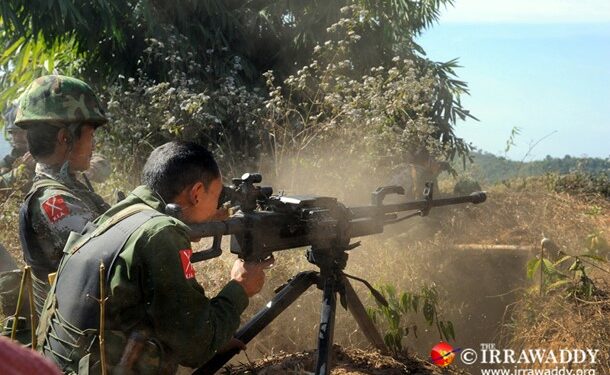The Burma Army conducted airstrikes on Friday in Kachin State’s Waingmaw Township, continuing a weeklong offensive against the Kachin Independence Army (KIA), a KIA spokesperson has told The Irrawaddy.
Offensives against the KIA’s Brigade 5 have been ongoing since earlier this week, while military maneuvers have increased against other KIA brigades—2, 3 and 4—in Kachin and northern Shan states for months, according to KIA spokesman Lt-Col Naw Bu.
Naw Bu said “two helicopter gunships shot at the Lai Hpau Bum [or Lai Hpau post] for about 30 minutes, starting at 2 p.m.” on Friday.
He told the Irrawaddy that since Tuesday, Burma Army troops used 120 mm and 105 mm artillery to attack Lai Hpau and nearby outpost Nhkaram, which are about three kilometers away from the Myitkyina-Bhamo highway.
The KIA troops are a security unit, used to defend the KIA headquarters in Laiza, which is about 30-40 kilometers from the current area of engagement.
Since fighting renewed in June 2011—after a 17-year ceasefire between the former military government and the KIA—the Burma Army has used its air force and artillery to attack the Laiza headquarters and its surrounding units numerous times.
The KIA has not yet signed the nationwide ceasefire agreement (NCA), which is a necessary step to take part in the national political dialogue at the decision-making level. However, leaders from the KIA’s political wing, the Kachin Independence Organization, joined the 21st Century Panglong Peace Conference—also called the Union Peace Conference—held in late August.
Naw Bu said that the offensives could be an effort to “put pressure on the KIA” to sign the NCA, in order to “implement the Burma Army’s plan to bring the disarmament, demobilization and reintegration of non-state armed groups,” which was raised by military representatives during the Union Peace Conference.
He added that the KIA “would have to continue defensive actions against the Burma Army troops.” The combined forces of the government’s Light Infantry Battalion (LIB) 381, LIB 121, Infantry Battalion (IB) 360, IB 50, IB 260 and IB 29 are stationed in the area. Since mid-2011, many locals in the area have fled their homes and those displaced are still unable to return.
The Irrawaddy tried to contact the government, its National Reconciliation and Peace Center and military spokespersons but they could not be reached for comment.

















